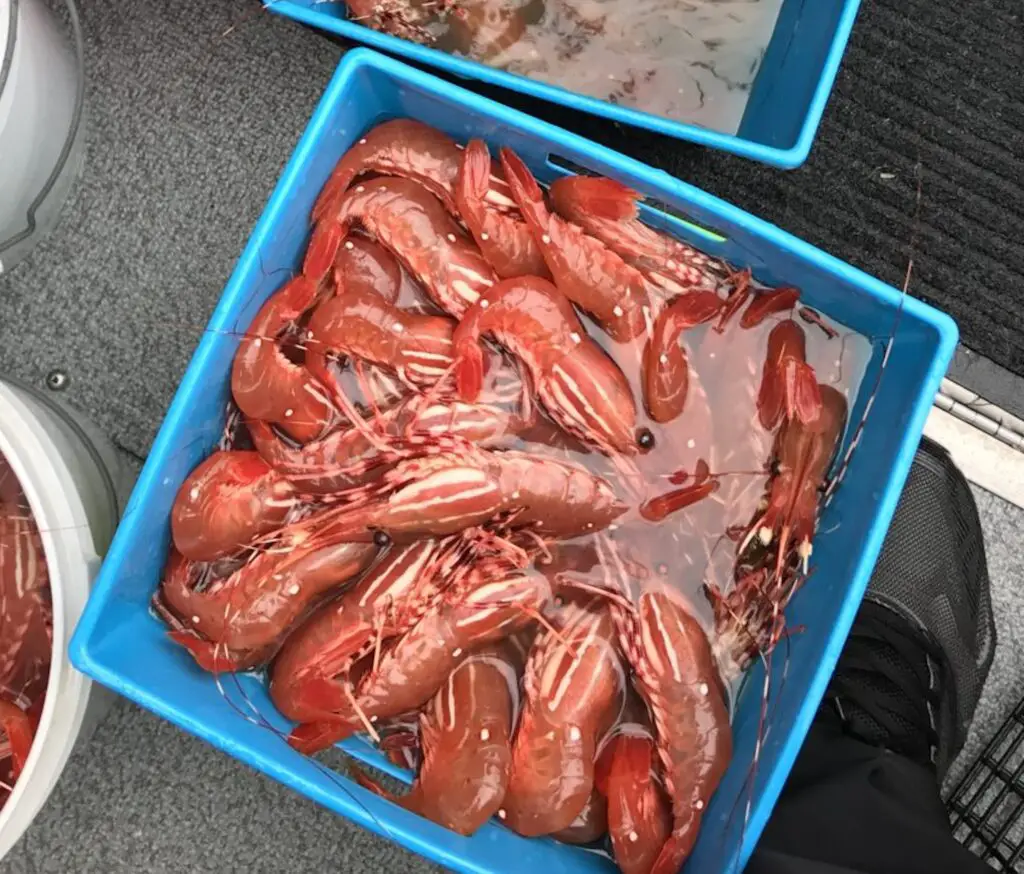
Spot shrimp are widely considered the most delicious and sought-after shellfish in Puget Sound. With their sweet, delicate flavor and firm texture, they’re a prize catch for any Pacific Northwest angler.
Having spent years shrimping throughout Puget Sound, Hood Canal, the Strait, and the San Juan Islands, I’ve learned what works, what doesn’t, and how to maximize your haul during a short opener.
Spot shrimp are also tremendously fun to catch. The boat launches and water on a shrimp opener on Puget Sound are as packed as you will see on any body of water.
I will never forget one of my first shrimping trips on Hood Canal where I arrived over an hour before the official opening time and the boat launch was empty. Why was it empty?
Because the parking lot was already full!
Everyone was already in the water circling their preferred shrimping spots. Exceptional turnout! Shrimping has a little bit of “Deadliest Catch” to it, because of the race against time to fill shrimp pots during the 4 hour openers in some areas.
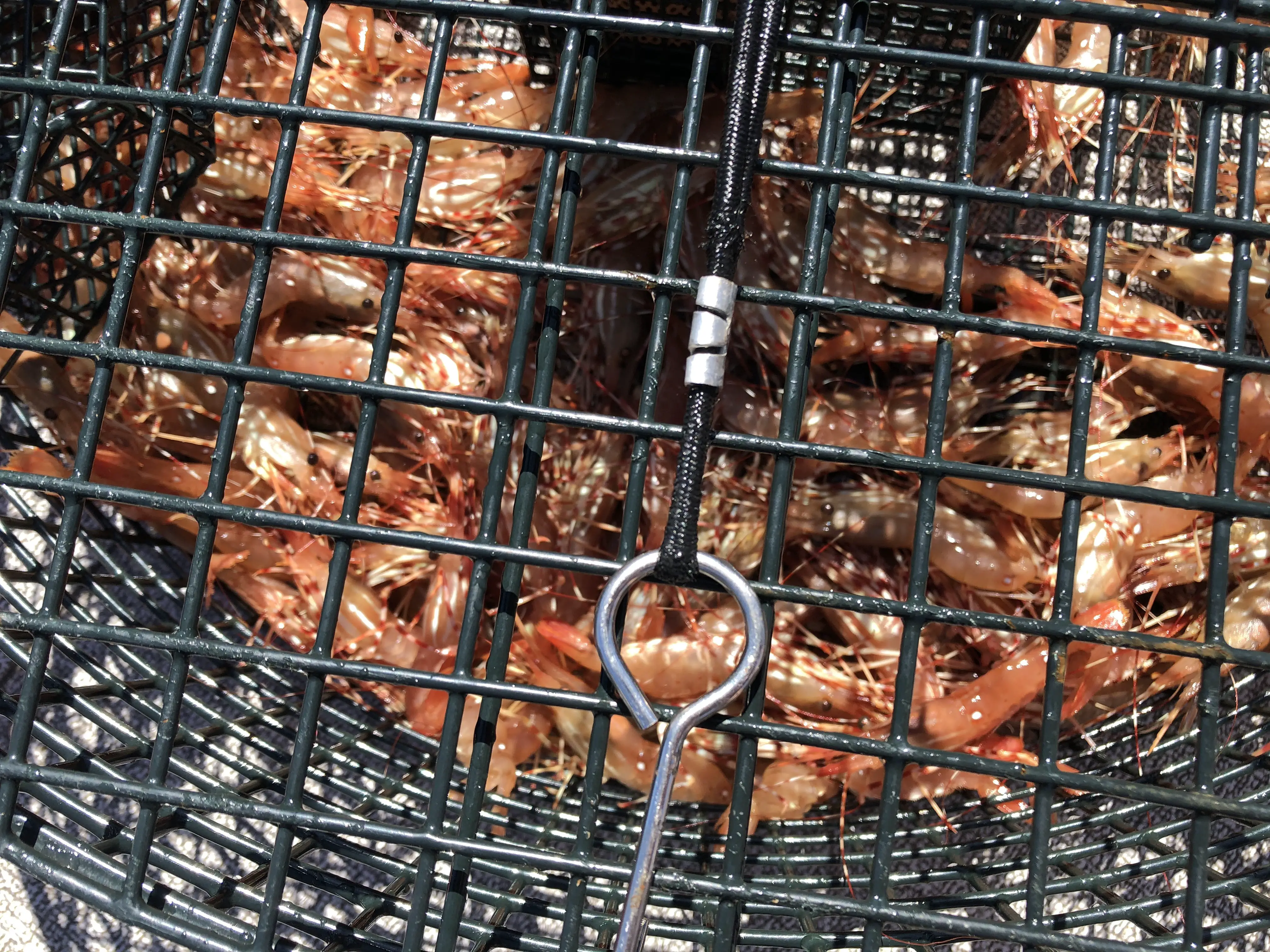
To be successful you really need to have everything ready to go the night before, pots rigged up, lines in order, bait mixed, and some idea of a strategy.
In this guide to Puget Sound Spot Shrimp, we will cover what kinds of shrimp pots you can buy and how to rig those pots. We will share thoughts on pot pullers, approach to bait, and a strategy for a 4 hour opener. Shrimping Seasons, tides and currents, and of course shrimping locations will also be covered.
Current Puget Sound Spot Shrimp Opportunities
The 2023 Puget Sound Spot Shrimp opportunity is long gone, but 2024 will be here before you know it!
Checkout one of our best videos from 2023 as well. The above video is a great refresher in prep for the season.
Latest Blog Posts about Spot Shrimp
- How to Prepare for the 2025 Puget Sound Spot Shrimp Season
- Opportunities all 2025 in the PNW to hunt, fish and forage
- 2024 Puget Sound Spot Shrimp Season
- 2023 Puget Sound Spot Shrimp Season
- The Spot Shrimp are shallower – June, 2022
What are the best shrimp pots for Puget Sound’s 4-Hour Openers?
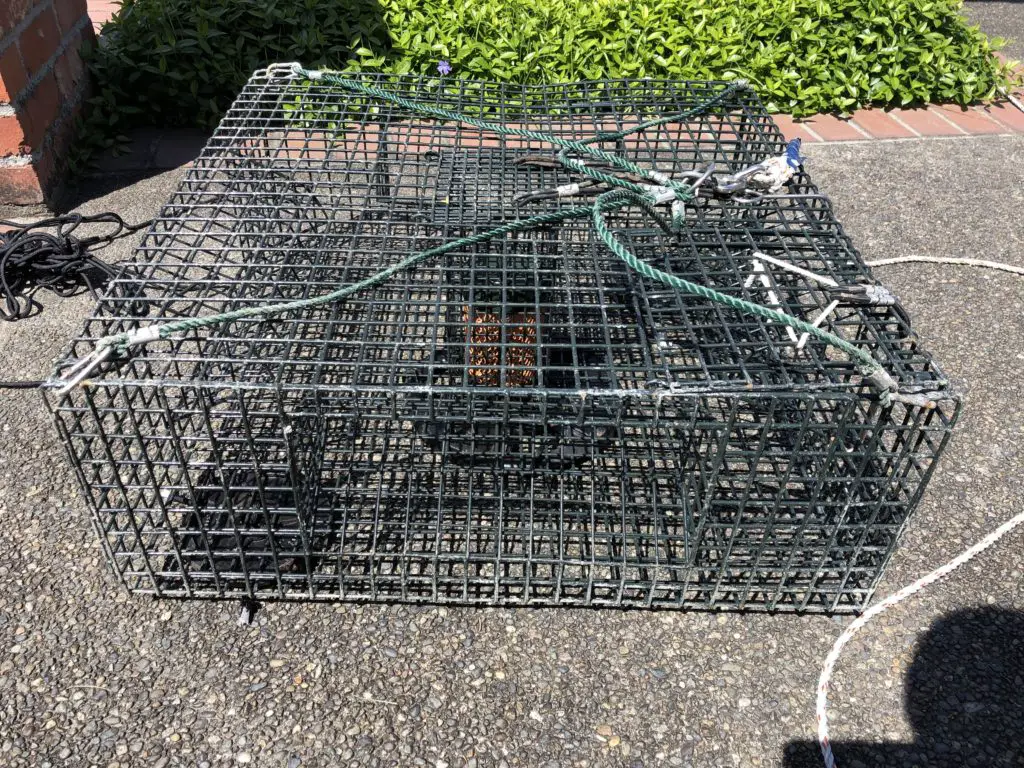
There are basically two different shrimp pot styles you can purchase:
- High-efficiency multi-tunnel shrimp pots which are optimal for fast fishing.
- Low-tunnel, long-soak pots where are optimal for overnight or multi-day soak.
The high-efficiency multi-tunnel shrimp pots are ideal for our 4-hour openers, or doing short soaks on a tide change in heavy-current locations like the Strait or San Juan Islands.
You can get good results on 45-60 minute soaks with the faster-fishing pots which optimizes your ability to locate shrimp and put limits on board during short openers.
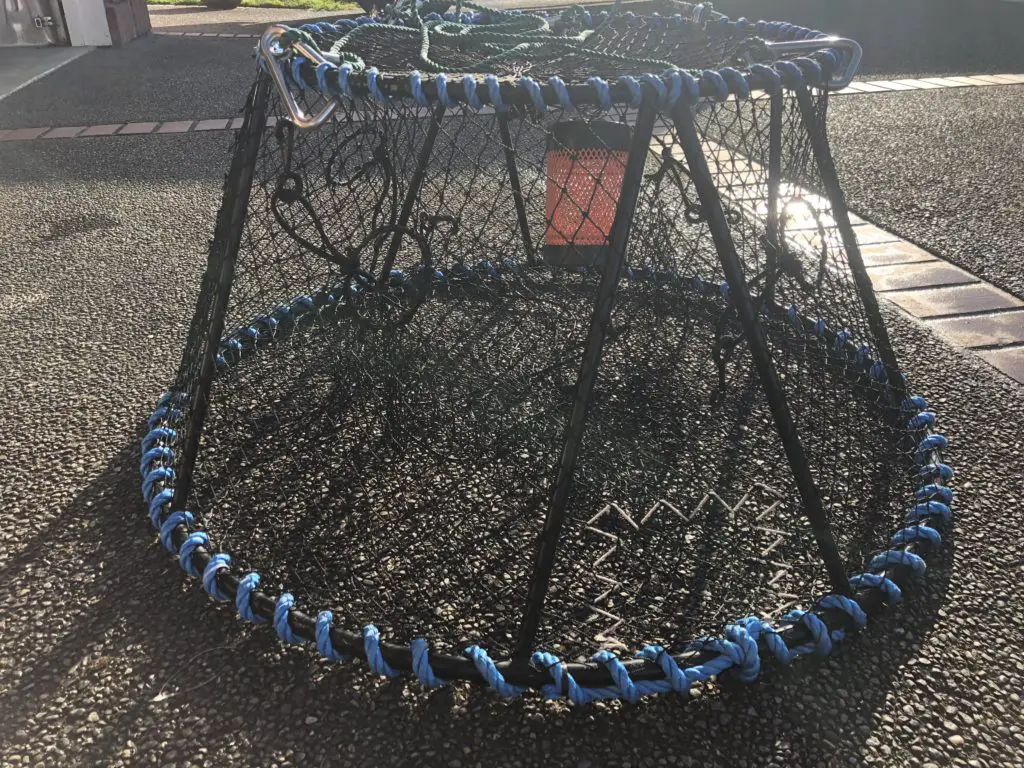
The slower fishing low-tunnel pots usually need a longer soak time of at least 1-1.5 hours soak as they have fewer tunnels. They will both fill with shrimp slowly, and it will also take the shrimp longer to leave the pot (this is also a function of the bait used, but more on that later).
These types of pots do gets used still in certain areas like the Straits and San Juans, but it’s rare to see them on 4 hour shrimp openers.
I’ve fished both pot types side by side and there’s definitely an advantage to fishing the high-efficiency multi-tunnel shrimp pots during short openers.
At the same time, with a 4-hour opener, you may only get 4 pot sets per pot, and having a pot that can fish effectively in less than an hour is also a real advantage.

One of my favorite shrimp pots I’ve fished with is a very large version of the faster fishing pot style made by McKay right there in Brinnon, WA.
Bigger, high-efficiency multi-tunnel wire pots hold more bait and more shrimp and can fish just as fast as the smaller ones. The Shrimp Coffin by McKay might be the ultimate. pot for short 4-hour openers.
These bigger wire pots do take up much more deck space on your boat though, so if you have a smaller boat or less deck space, you should also factor that in.
How to rig pots for Puget Sound Spot Shrimp
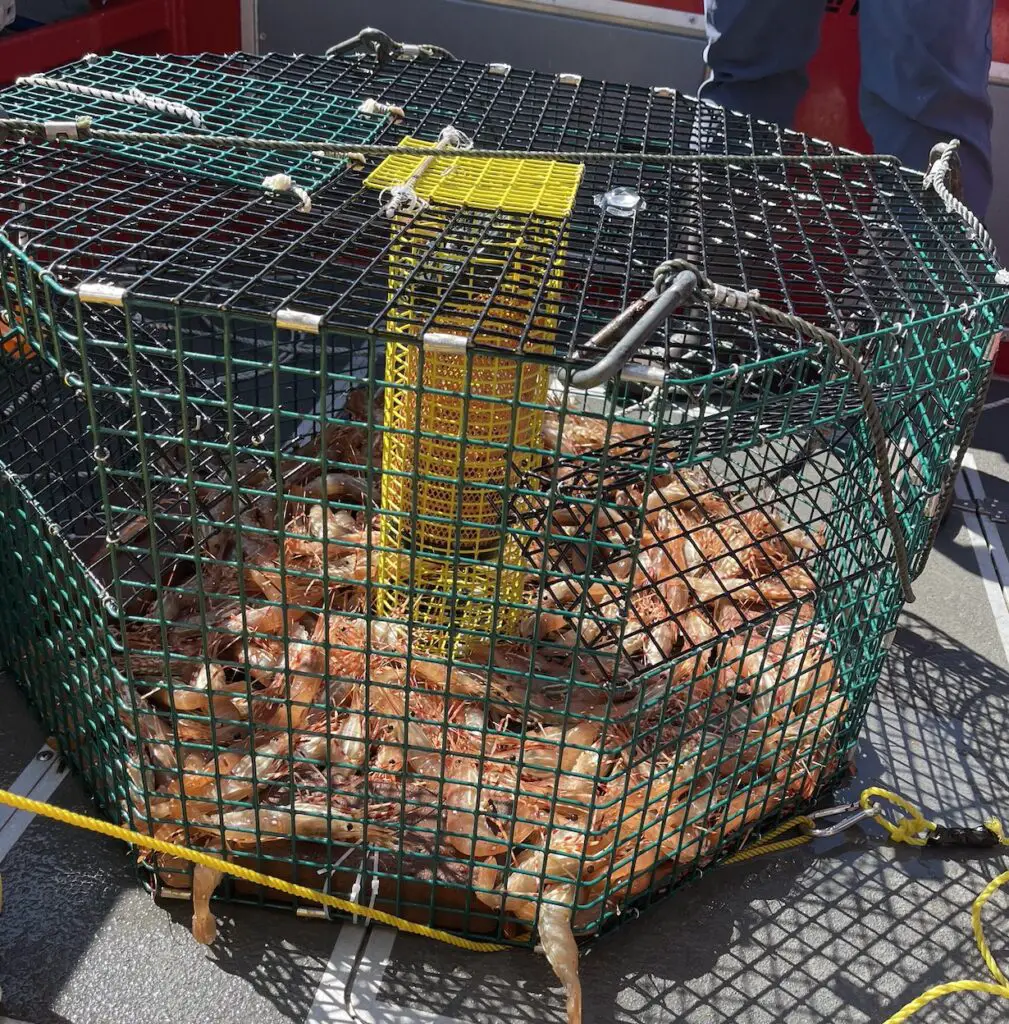
I’ve pulled up my most shrimp per pot with the above fast-fishing octagon pot loaded with lots of bait.
There are many successful ways to rig shrimp pots and both fast and slow pot types have some pot-specific variables to pay attention to, but all pots need to have the appropriate amount of weight, floatation, and rope setup.
How much weight should a shrimp pot have?
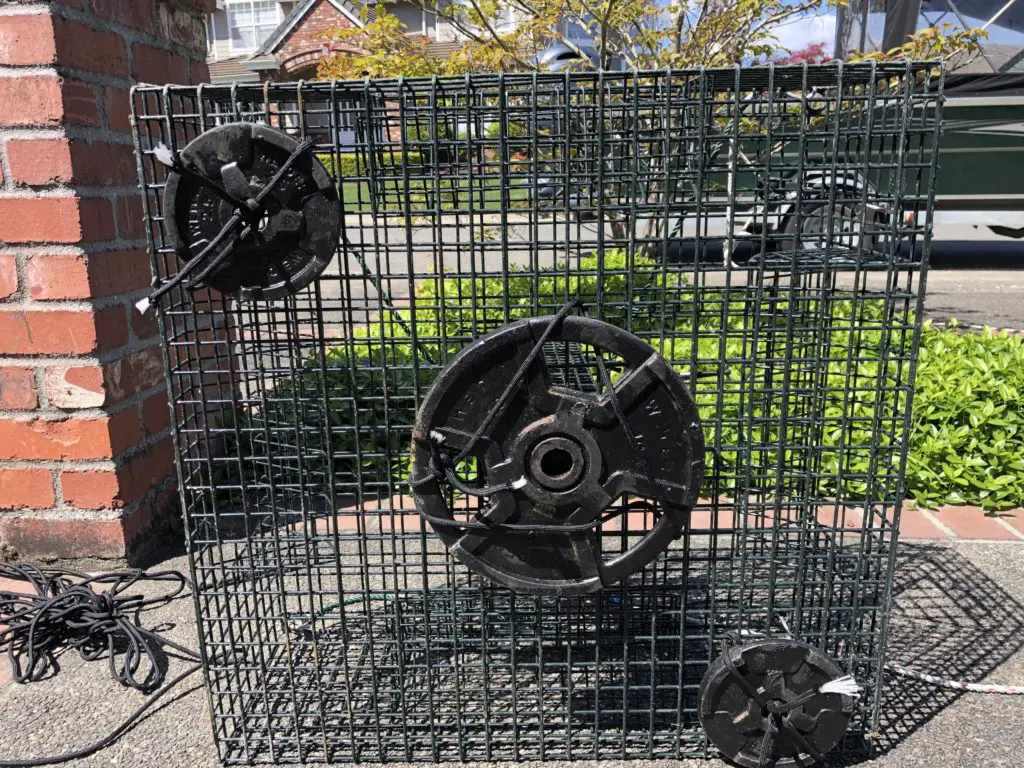
- Each pot should weigh at least 30 pounds in total.
- You can buy pot weights designed by SMI or KUFA and tie them into your lighter pots by tying them to the corners away from the tunnels.
- You can also make use of those old gym weights you never use, spray them with Plasti Dip to protect from corrosion.
- My favorite way to weigh my shrimp pots is captured on this page here. You can get to 30 lbs with only 20-30$ and it’s by far the cheapest way I’ve found that doesn’t depend on material lying around that can be re-purposed.
The topic of pot weight ties to shrimping tides and currents, discussed later, but always ensure proper weighting/anchoring to prevent pots from drifting off.
How much floatation should a shrimp pot have?
Your pots need sufficient floatation, but you should also consider breaking your floatation into two parts. Too much floatation in a single buoy will lead to your pot being bounced around on the bottom as the wind, waves, and boat traffic move your floatation around on the surface.
The pot moving around on the bottom will cause shrimp to abandon your pots quite readily.
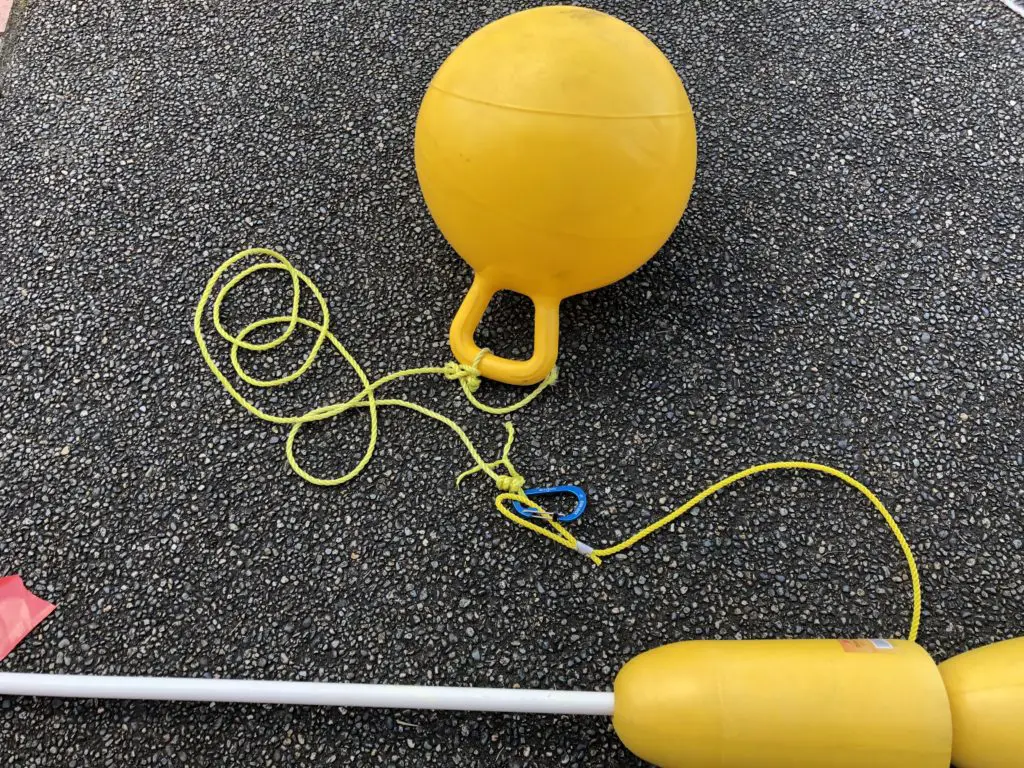
I recommend breaking your flotation into a buoy or buoy stick setup that is directly on your main shrimping line, with an additional buoy attached to that buoy setup.
Think of the additional buoy as purely just insurance.
There are a variety of scenarios that will cause your buoy stick to sink beneath the surface and you need that extra floatation to be able to find your pot again.
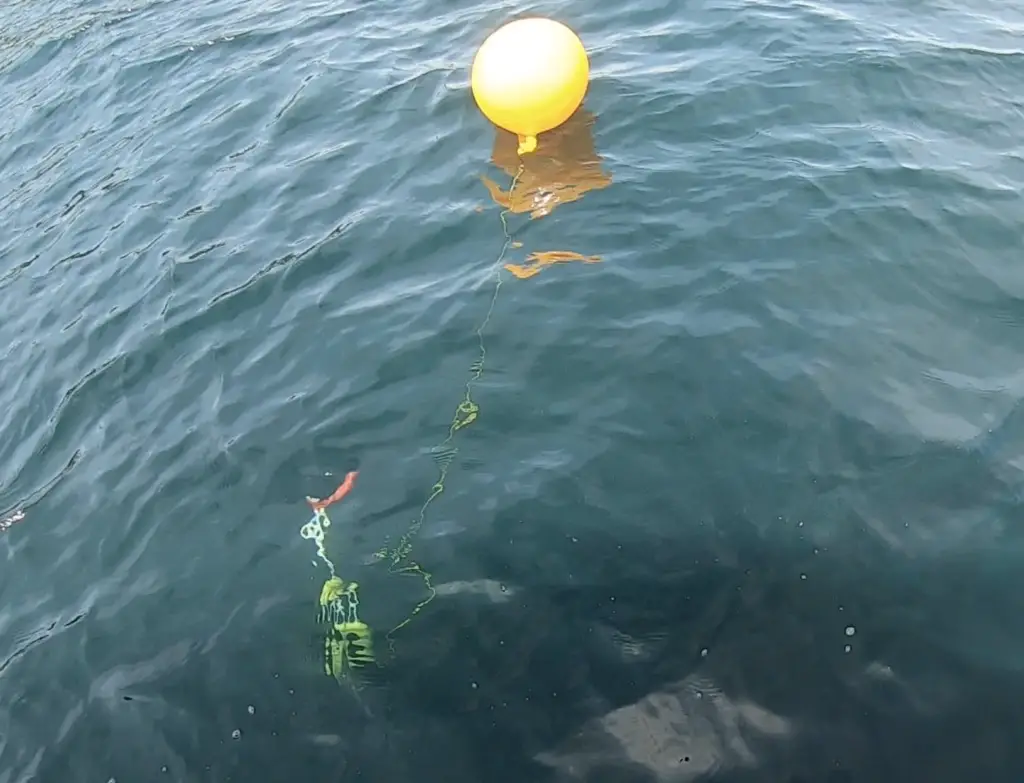
One such scenario happened to us on the 2019 Shrimp opener while shrimping near Vashon Island. Something happened to our pot, likely the pot anchor tangled with another pot placed too close to ours and dragged the entire buoy stick underwater. Only the insurance buoy was showing!
How to use shrimp pot anchors for added stability?

One thing you can do to aide in pot stillness is add a small folding anchor to your mainline 10-15 feet up from your shrimp pot.
I usually use about 6-8 ft of lead core line and a crab-style clip to attach it to my mainline shortly after my pot goes overboard.
This will have the effect of absorbing the movement of the float on the surface and preventing that movement from translating to pot movement on the sea floor.
For the slower fishing round pots, you want to put the folding anchor line off the pot itself, as these round pots have a tendency to roll if they don’t land perfectly on the seafloor.
You can also ensure a flush landing by controlling your boat to be right above your pot as it drops and then pulling on the line to ensure it is truly stuck.
This also helps if the pot harness is rigged to the opposite side of where you place the pot anchor line.
How to manage the lines on shrimp pots to maximize catch efficiency?
In almost every case, the primary challenge to shrimping gear is line management.
Each boat can have a maximum of 4 shrimp pots onboard.
With a minimum of 400’ of lead core line per pot, that’s 1600’ feet of rope onboard that needs to be safely and effectively managed as part of dropping pots and pot retrieval.
There are a number of ways to make line management easier, but breaking your line attachments into detachable components really helps the process be smooth, safe, and efficient. Also, check out the above video for our system.
SMI makes their own rope winder device which you can now purchase via Amazon:
As an Amazon associate we get a small commission if you use the above link to purchase, even though you get the same price regardless. Thanks for supporting the blog!
What’s the best Pot Puller for Puget Sound Spot Shrimp?
Below are product descriptions and helpful links to purchase from Amazon.
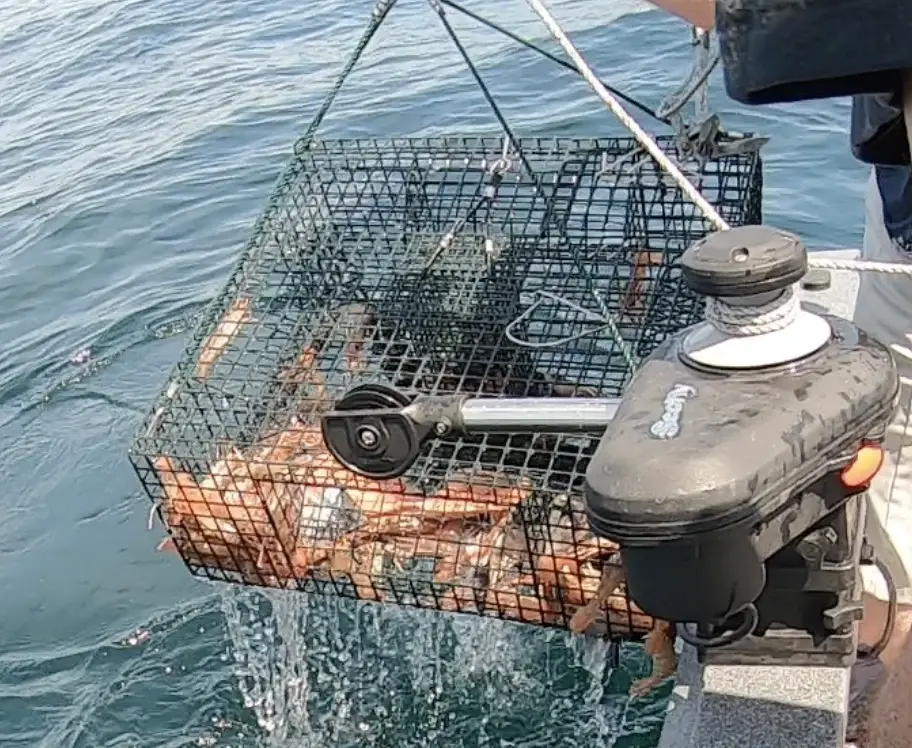
In terms of a pot puller, there are a few considerations like budget, number of people in your “shrimping crew,” and health/fitness level.
We’ve used the Scotty pot puller as a great budget pot-pulling device, and while it greatly helps reduce the stress of the many pot-pulls associated with a day of shrimping, it still requires that you do some slight pulling to get it started and keep line-feeding through the puller.
You can spend more money on a device that will perform a greater share of the heavy lifting and allow you to focus on line management, which could be invaluable if you are shrimping by yourself, or maybe you’re the only one on the boat capable of these various tasks.
Shrimping by yourself would certainly be a challenge, though not impossible. Shrimping with a crew is a great way to go after it, especially if everyone is working together and on the same page.
The Brutus Maxtorque Line Hauler is what we use now, and it’s a great way to go if you have to do most of the work yourself for a bit more cost. Want to take the kids out shrimping by yourself for their extra licenses = more shrimp? You will need to be able to handle these tasks efficiently.
With the Brutus and my shrimp line management system, I can now do all the shrimp pot setting and retrieval by myself. The Scotty requires constant tension on the line and is more like a “helper” than doing it all for you.
Line management, as mentioned earlier, is the most intimidating aspect of shrimping. If you are out there waiting for the opening and just starting to unpack your shrimp lines…You are in for a long and not very enjoyable day.
Make sure your lines are in good shape and coiled up properly long before you ever go shrimping to save yourself a significant headache.
What kind of habitat do Puget Sound Spot Shrimp live in?
There are a variety of depths and habitats that hold spot shrimp throughout Puget Sound, but you are primarily looking at depths from 250-300 ft deep, and typically on a slope just above a flatter much deeper area.
They can be found in much shallower depths as well, but this can be heavily dependent on weather and other factors as they can be light-sensitive.
For example in 2022, the best shrimping depths in Hood Canal were from 150 – 220 ft vs a more typical 250+.
In 2023, it seemed like around 230 ft was the key depth for where we like to shrimp. In 2024, our best pot came from 310 ft. I key factor for getting limits of spot shrimp is figuring out what depth they are at.
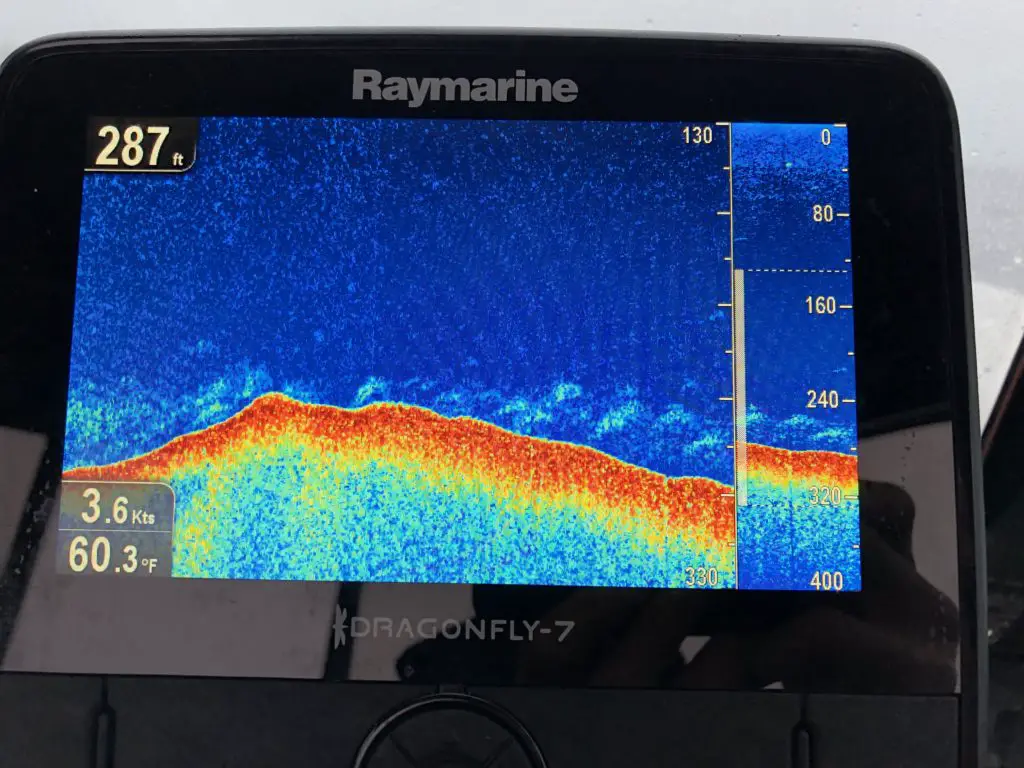
When there are enough spot shrimp in the area, and currents are slack enough for them to move around they should show up on good electronics as a cloud hovering just above the sea floor.
They may also show up more faintly or even not at all if they are hunkered down, holding on to the bottom. I’ve seen massive amounts of shrimp come over the rails in areas with what seemed like no shrimp on the sonar!
Where to find Puget Sound Spot Shrimp?
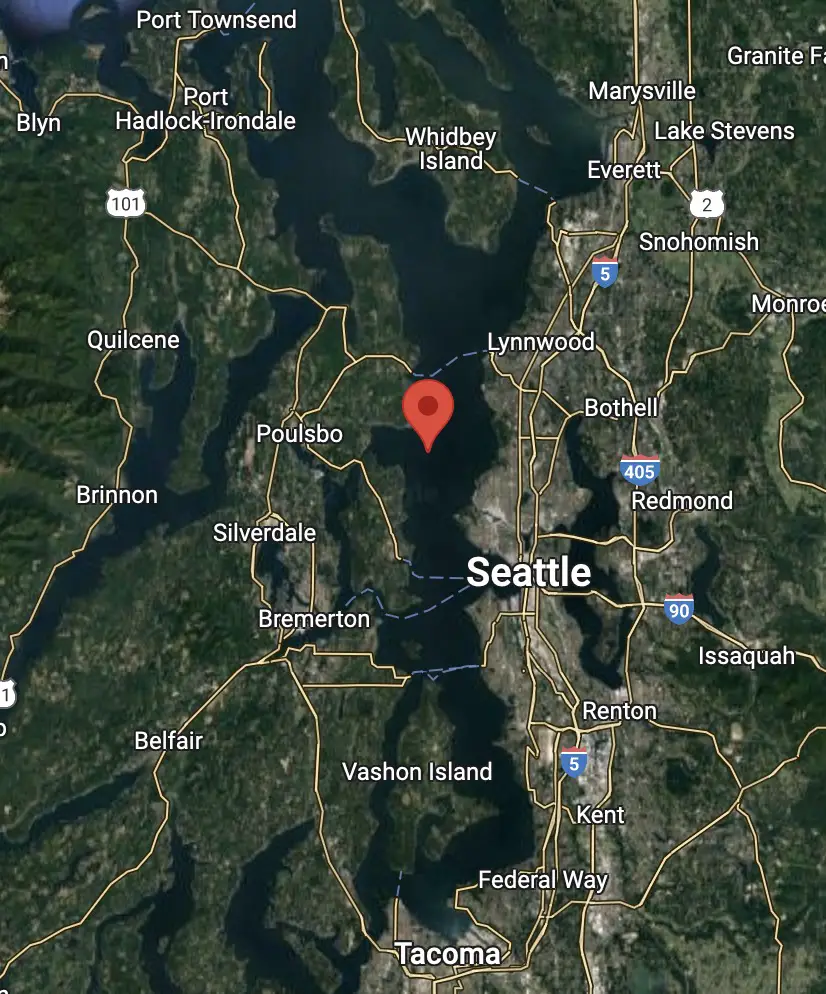
One of the most obvious strategies for finding good spot shrimp locations is to just follow other boats and fish at a respectful distance from them in the areas they end up in. You cannot miss where people are shrimping, given the clusters of boats and bright yellow buoys you will see dotting the area.
There are a few problems with this strategy though:
- You don’t really know if the folks you are following know what they are doing or if they have a good shrimping location figured out. Even the evidence of many boats is not necessarily a tell due to the human herd nature. In that, we assume that if there are lots of boats in an area, it must be good.
- More boats = more competition = less shrimp per pot. Now, there are some truly great shrimp spots that will draw in many boats, and it’s where you want to be. But don’t assume that’s always the case. We had a tough go of it shrimping in close proximity with 15 other boats in an area of Hood Canal that didn’t have a ton of shrimp. It’s tough to move, though, once you’ve got 4 pots down and you’re in the middle of attempting to grind it out.
The more shrimping I’m doing, the better I’m getting at identifying new potential locations on a Bathymetric chart like what you will find on the Garmin Boating App.

You start to notice a few patterns in the geography that shrimp clearly prefer. Sure, you could just fish close to home and go back to the same spots each year, but unless you live near the San Juans or the Strait, you aren’t getting many cracks a it.
So you want to make sure you are picking good locations to invest your shrimping time.
The key is to realize that shrimp are extremely current-sensitive. If you could only eat food in soft enough currents, you wouldn’t spend a lot of time in areas where a soft current is rare.
The mindset is very similar to reading water on a river and only targeting the preferred holding water. Ignore 90% of the other water.
For Spot Shrimp, you are looking for anything that breaks up the current of the main channel. Deeper water off of bays or in-cuts of the bathymetric lines and deeper areas, which denote places where the current may slow down a bit, are all good bets.
If you find an area with a deep flat from 200-250 ft leading to a deeper drop-off down to 300-400 ft, targeting the top of that slope below the deep flat can be a great option as well.
Shrimping the South Sound – Marine Area 11 and 13 Tips
Marine Area 13 typically does not have enough spot shrimp to sustain an opener.
There are however better numbers of shrimp in Marine Area 11. Most of the successful shrimping in MA11 is done on the south or east side of Vashon Island.
Checkout our more detailed page on Shrimping in Marine Area 11 for more information.
Shrimping Hood Canal – Marine Area 12 Tips
Checkout my latest report on Hood Canal Shrimping for some specifics on locations on Hood Canal.
Shrimping the San Juan Islands – Marine Area 7 Tips
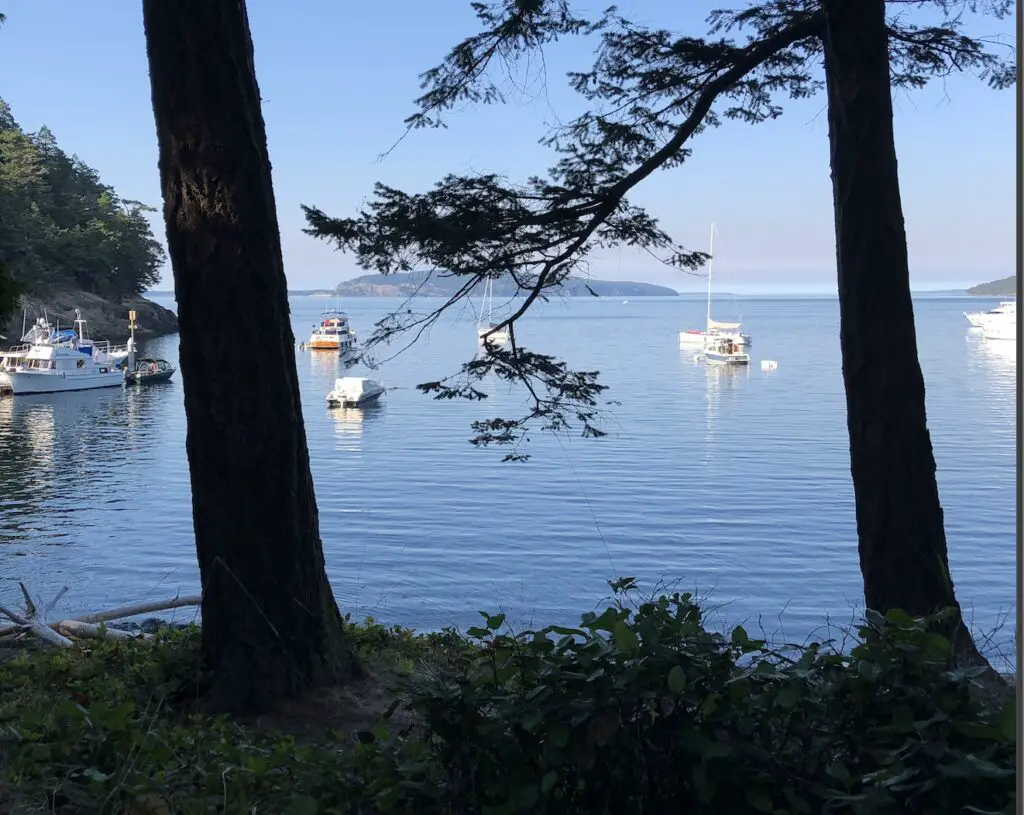
The San Juan Islands shrimping areas are broken up into West, East and South.
In the West you have areas near Waldron Island, John’s Island and Stuart Island along with San Juan and Spieden Channels. I’ve only shrimped the Waldron / John’s island location personally.
In the South, you have Iceberg Point, which may be the best-known shrimping area in the Islands and can be fantastic, but is also super exposed to a south wind and the bigger water of the strait. There are also several other locations along southern Rosario.
In the north you have areas along northern Rosario, Bellingham Bay and Sucia Islands.
Shrimping the Strait – Marine Area 5 and 6 Tips
There are quite a few potential locations here, more so in the eastern straits aka Area 6. Eastern Bank can be fantastic but is very exposed to big water. I’ve generally tried to find a bit more protection and targeted areas around Dallas Bank.
You can read a bit more about shrimping in the Strait of Juan de Fuca and our trip in June 2019. We cover a few locations in more protected water worth trying.
What are the best tides and currents for spot shrimp?
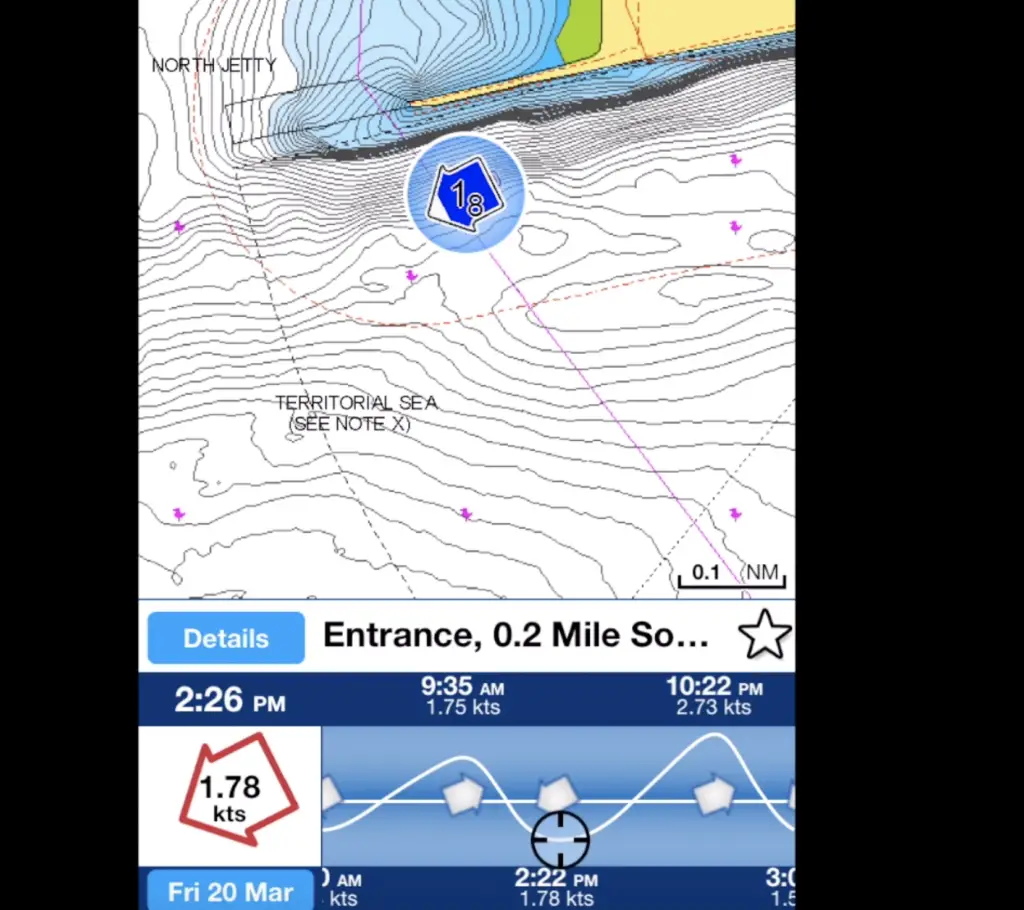
Understanding tides and currents might be the most important factor in targeting Puget Sound Spot Shrimp. Get this wrong and you are wasting your time, or worse, you may lose all your shrimp gear.
Shrimp are only active at very low tidal currents. If you think you can drop your shrimp pots in a good location, with good bait and rigged up properly, but during the wrong tide or part of the tide, you will quickly learn how this is not the case.
Even a marginal tidal current of say .3 knot current won’t perform nearly as well as a .1 or .15 knot current.
Regarding the risk of losing your pots, remember that you are often dropping them on a slope just above even deeper water, so even properly weighted and anchored, all that current acting on your 400 ft of line can still move your pots into deeper water and force you to go looking for your pots.
And if you don’t have proper floatation, you may just be flat out of luck.
How do you know which tides are the best for shrimping? Look for tides with low tidal exchange.
Tidal exchange is the absolute difference from low tide to high tide for a flood tide, or from high tide to low tide in the case of an ebb. So, a high tide of 7 ft and a low tide of 5 ft would be a tidal exchange of 2 ft.
One of the best tools for selecting the right shrimping tides is the Garmin Boating App again. It’s also helpful for finding ideal shrimping locations. Garmin Boating will show you the expected tidal current days, weeks, or months in advance for a given part of Puget Sound.
What’s the best strategy for Puget Sound Spot Shrimp?
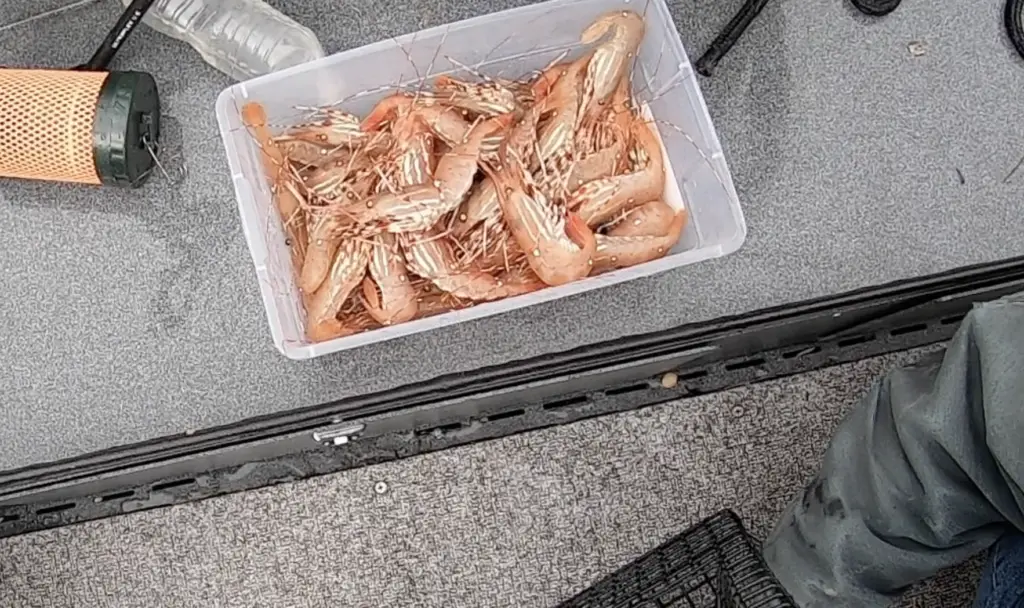
Outside of all the preparation that can be done in the weeks, days, or the night before, you should have a game plan worked out for what you will do once you are out there.
If you get out there and just expect to find your shrimping spot before the opening bell hits, you might be hard-pressed to have success that day. You and hundreds of other boats will be going through the same exercise.
So why not get a jump on things and pre-scout the area prior to the morning of? Expect heavy competition in the well-known areas as well as good areas closest to boat ramps and launches.
I also like to get my pots down in my preferred location as fast as possible, because in competitive areas, you will run out of real estate quickly if you take too much time to get your pots down.
If you are unsure of the correct depths to set at, make sure your 4 pots cover multiple depths from 220 to 310 ft, and then move under-performing pots to better-performing depths on the next set.
What is the best bait for Puget Sound Spot Shrimp?
Like all aspects of shrimping, there are many ways to be successful, and bait is no exception.
There can be very simple approaches, such as grinding up shrimp pellets with shrimp oil, having 2-3 different bait strategies in the same pot, and everything in between. I’ve started to use similar bait strategies for both shrimp and crab in many ways, as what they key in on is quite similar.
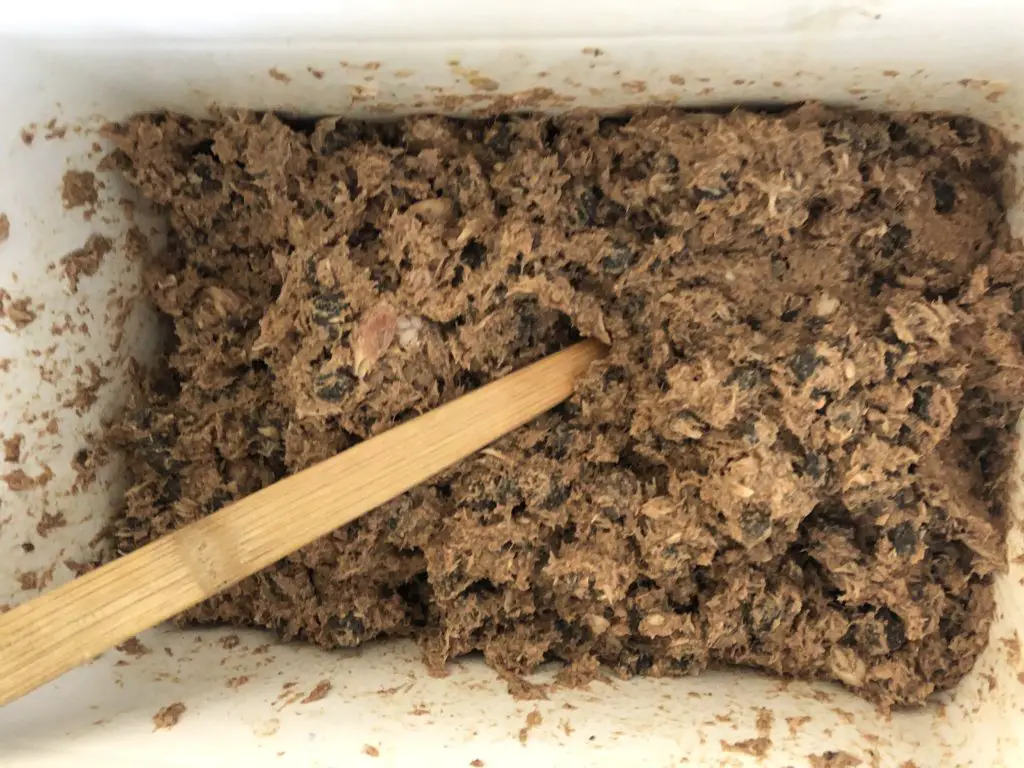
I like to take shrimp pellets, grind them up a bit, mix them with canned mackerel and canned catfish of the Ocean Whitefish, and Tuna variety.
You will need a bait barrel to contain your bait mixture that will allow it to milk out at just the right speed to attract and keep shrimp in your pots.
Make sure you choose the right size for your shrimp pot!
Add in some amount of Pautzke’s or ProCure Crab and Shrimp fuel and mix it all really well.
I scoop my meaty mixture into bait canisters until packed about 3/4 full, and then, after retrieving the pots, I will add whatever is left in the canisters back to my bait mixture. I can then rehydrate and reuse the bait by adding more oil, canned mackerel, or cat food.
I’ve learned to use a runnier bait (more mackerel and more oil) when tidal currents are less so that it will milk out faster and still attract lots of shrimp.
This mixture, and the process of mixing and re-using, allows me to effectively and efficiently use my bait throughout the shrimp season and then roll it right over to the crab season. If you shrimp often enough, though, your pellets will break down, requiring that you add more fresh pellets at some point.
I may also include a hanging bait at times that can keep shrimp in the pot feeding, even if the milking of the bait mixture and oil has slowed down.
I’ve also learned to keep extra amounts of all bait ingredients on my boat in case I need to adjust the mixture while shrimping.
Summary on Puget Sound Spot Shrimp
- Preparation is key to shrimping success – Everything should be ready to go by the night before. Don’t discover on the day of that you are missing a key piece of equipment.
- Select shrimping equipment that works best for you, your crew (type of pot puller/line hauler), and your location (fast vs slow pot type).
- Pick a shrimping strategy based on time allotted for the opener and competition from other boats.
- Always always always pick the right tides and currents for shrimping, especially in the Strait and San Juans.
- Get out there and participate in every shrimp opportunity you can, to enjoy one of the funnest harvesting activities and tastiest critters in Puget Sound.
thank you for all your information I have lived on the straits but have never gone shrimping me and my son want to try so all information is needed we will get a three day trip we are from walla walla so thank you again. tim parks
Thanks man, appreciate that! Shrimping is one of our favorite PNW activities. We cannot wait for the opener this year, hopefully in a couple of weeks.
how long does your shrimp bait last? Like, would you make a bunch one day and use that over 4 days? How perishable is it?
Yes. I make a bunch of it in a cooler that I can put in my freezer for storage longer than a few days, or I leave in a cooler in the garage with some frozen water bottles that I rotate around. I basically treat it like low quality refrigerator requirement type. But I don’t worry about it getting a little bit warm or being frozen or re-frozen multiple times. I’m on day 4 of shrimping over the past 2.5 weeks with the same basic stuff. You will notice your shrimp pellets get pretty soft after a bit, so I will refresh it with more shrimp pellets, oil and other ingredients.
Great information! Thanks! But where do I go to find shrimp pellets?
Thanks
Jerry,
Thanks for reading and commenting! I’m excited that you’re already thinking about this upcoming shrimp season! Most of the time, your local sporting goods store will carry them. I’ve bought them at Sportco in Fife and also Sportsmans Warehouse in Puyallup…
You may not find them until closer to the shrimping season however as they are definitely a seasonal item.
Thanks,
Kyle